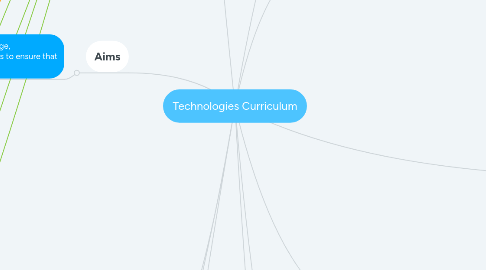
1. Aims
1.1. To develop the knowledge, understandings and skills to ensure that students:
1.1.1. Investigate, design, plan, manage, create and evaluate solutions
1.1.2. Are creative, innovative and enterprising when using all technologies, and understand how they have developed over time
1.1.3. Make informed and ethical decisions about technologies in the economy, environment and society in regards to a sustainable future
1.1.4. Engage confidently and responsibly with appropriate technologies such as materials, data, systems, components, tools and equipment when designing and creating solutions
1.1.5. Critique, analyse and evaluate problems, needs or opportunities to identify and create solutions
1.1.6. Produce designed solutions suitable for a range of Technologies contexts by selecting and manipulating a range of materials, systems, components, tools and equipment creatively, competently and safely
1.1.7. Understand the roles and responsibilities of people in design and technologies occupations and how they contribute to society
1.1.8. Use computational thinking and the key concepts of abstraction; data collection, representation and interpretation; specification, algorithms and implementation to create digital solutions
1.1.9. Confidently use digital systems to efficiently and effectively transform data into information and to creatively communicate ideas in a range of settings
1.1.10. Apply systems thinking to monitor, analyse, predict and shape the interactions within and between information systems and understand the impact of these systems on individuals, societies, economies and environments
2. Subjects
2.1. Design & Technologies
2.2. Digital Technologies
3. Strands
3.1. Knowledge & Understanding
3.1.1. Technologies & Society
3.1.1.1. The use, development & impact technology has on peoples lives
3.1.2. Technologies Contexts
3.1.2.1. Food & Fibre Production
3.1.2.2. Engineering principles and systems
3.1.2.3. Food specialisation
3.1.2.4. Materials & technologies specialisation
3.1.3. Digital Systems
3.1.3.1. Components of digital systems & their use
3.1.4. Representation of Data
3.1.4.1. How data is represented and structured symbolically
3.2. Processes & Production Skills
3.2.1. Creating Solutions by
3.2.1.1. Investigating & defining
3.2.1.2. Designing
3.2.1.3. Producing & implementing
3.2.1.4. Evaluating
3.2.1.5. Collaborating & managing
3.2.2. Digital implementation
3.2.2.1. The process of implementing digital solutions
3.2.3. Collecting, managing and analysing data
3.2.3.1. The Nature & properties of data
4. Key Concepts
4.1. Abstraction
4.2. Data Collection, data representation and data interpretation
4.3. Specification, Algorithms and implementation
4.4. Digital systems
4.5. Interactions and impact
5. Resources
5.1. Kodable
5.1.1. Technology Resources ‹ Log In
5.2. Ecospace
5.2.1. Technology Resources ‹ Log In
6. General Capabilities
6.1. Literacy
6.2. Numeracy
6.3. Information & Communication Technology (ICT) Capability
6.4. Personal & Social Capability
6.5. Ethical Understanding
6.6. Intercultural Understanding
7. Key Ideas
7.1. Engineering principles and systems
7.2. Food and fibre production
7.3. Food specialisations
7.4. Materials and technologies specialisations
7.5. Collecting managing & analysing data
7.6. Digital Implementation
8. Student Diversity
8.1. Students with disability
8.1.1. Support must be provided to students with a disability in order to access the curriculum on the same basis as students without a disability.
8.1.1.1. Curriculum adjustments
8.1.1.2. Delivery adjustments
8.2. English as an additional language or dialect
8.2.1. Students must achieve the technologies aims while simultaneously learning a new language, learning content and skills
8.2.1.1. Students may require additional time, support and explicit teaching
8.3. Gifted & Talented Students
8.3.1. Technologies should be used flexibly to meet the individual learning needs of gifted and talented students
9. Cross-Curriculum Priorities
9.1. Aboriginal & Torres Strait Islander histories & culture
9.2. Asia & Australia's Engagement with Asia
9.3. Sustainability
10. Band Levels
10.1. Australian Curriculum
10.1.1. Foundation to Year 2
10.1.2. Year 3 and 4
10.1.3. Year 5 and 6
10.1.4. Year 7 and 8
10.1.5. Year 9 and 10
10.2. Western Australian Curriculum
10.2.1. Pre Primary
10.2.1.1. both technologies subjects
10.2.2. Year 1
10.2.2.1. both technologies subjects
10.2.3. Year 2
10.2.3.1. both technologies subjects
10.2.4. Year 3
10.2.4.1. both technologies subjects
10.2.5. Year 4
10.2.5.1. both technologies subjects
10.2.6. Year 5
10.2.6.1. both technologies subjects
10.2.7. Year 6
10.2.7.1. both technologies subjects
10.2.8. Year 7
10.2.8.1. both technologies subjects
10.2.9. Year 8
10.2.9.1. both technologies subjects
10.2.10. Year 9
10.2.10.1. Optional
10.2.11. Year 10
10.2.11.1. Optional
